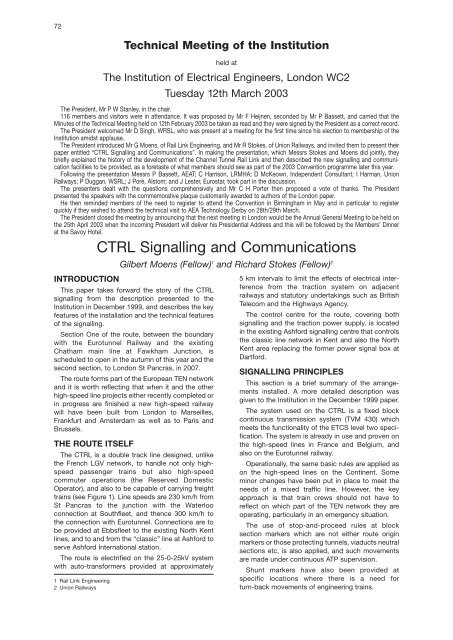Proceedings 2002/2003 - IRSE
Proceedings 2002/2003 - IRSE
Proceedings 2002/2003 - IRSE
Create successful ePaper yourself
Turn your PDF publications into a flip-book with our unique Google optimized e-Paper software.
72<br />
Technical Meeting of the Institution<br />
held at<br />
The Institution of Electrical Engineers, London WC2<br />
Tuesday 12th March <strong>2003</strong><br />
The President, Mr P W Stanley, in the chair.<br />
116 members and visitors were in attendance. It was proposed by Mr F Heijnen, seconded by Mr P Bassett, and carried that the<br />
Minutes of the Technical Meeting held on 12th February <strong>2003</strong> be taken as read and they were signed by the President as a correct record.<br />
The President welcomed Mr D Singh, WRSL, who was present at a meeting for the first time since his election to membership of the<br />
Institution amidst applause.<br />
The President introduced Mr G Moens, of Rail Link Engineering, and Mr R Stokes, of Union Railways, and invited them to present their<br />
paper entitled “CTRL Signalling and Communications”. In making the presentation, which Messrs Stokes and Moens did jointly, they<br />
briefly explained the history of the development of the Channel Tunnel Rail Link and then described the new signalling and communication<br />
facilities to be provided, as a foretaste of what members should see as part of the <strong>2003</strong> Convention programme later this year.<br />
Following the presentation Messrs P Bassett, AEAT; C Harrison, LRMHA; D McKeown, Independent Consultant; I Harman, Union<br />
Railways; P Duggan, WSRL; J Poré, Alstom; and J Lester, Eurostar, took part in the discussion.<br />
The presenters dealt with the questions comprehensively and Mr C H Porter then proposed a vote of thanks. The President<br />
presented the speakers with the commemorative plaque customarily awarded to authors of the London paper.<br />
He then reminded members of the need to register to attend the Convention in Birmingham in May and in particular to register<br />
quickly if they wished to attend the technical visit to AEA Technology Derby on 28th/29th March.<br />
The President closed the meeting by announcing that the next meeting in London would be the Annual General Meeting to be held on<br />
the 25th April <strong>2003</strong> when the incoming President will deliver his Presidential Address and this will be followed by the Members’ Dinner<br />
at the Savoy Hotel.<br />
CTRL Signalling and Communications<br />
Gilbert Moens (Fellow) 1 and Richard Stokes (Fellow) 2<br />
INTRODUCTION<br />
This paper takes forward the story of the CTRL<br />
signalling from the description presented to the<br />
Institution in December 1999, and describes the key<br />
features of the installation and the technical features<br />
of the signalling.<br />
Section One of the route, between the boundary<br />
with the Eurotunnel Railway and the existing<br />
Chatham main line at Fawkham Junction, is<br />
scheduled to open in the autumn of this year and the<br />
second section, to London St Pancras, in 2007.<br />
The route forms part of the European TEN network<br />
and it is worth reflecting that when it and the other<br />
high-speed line projects either recently completed or<br />
in progress are finished a new high-speed railway<br />
will have been built from London to Marseilles,<br />
Frankfurt and Amsterdam as well as to Paris and<br />
Brussels.<br />
THE ROUTE ITSELF<br />
The CTRL is a double track line designed, unlike<br />
the French LGV network, to handle not only highspeed<br />
passenger trains but also high-speed<br />
commuter operations (the Reserved Domestic<br />
Operator), and also to be capable of carrying freight<br />
trains (see Figure 1). Line speeds are 230 km/h from<br />
St Pancras to the junction with the Waterloo<br />
connection at Southfleet, and thence 300 km/h to<br />
the connection with Eurotunnel. Connections are to<br />
be provided at Ebbsfleet to the existing North Kent<br />
lines, and to and from the “classic” line at Ashford to<br />
serve Ashford International station.<br />
The route is electrified on the 25-0-25kV system<br />
with auto-transformers provided at approximately<br />
1 Rail Link Engineering<br />
2 Union Railways<br />
5 km intervals to limit the effects of electrical interference<br />
from the traction system on adjacent<br />
railways and statutory undertakings such as British<br />
Telecom and the Highways Agency.<br />
The control centre for the route, covering both<br />
signalling and the traction power supply, is located<br />
in the existing Ashford signalling centre that controls<br />
the classic line network in Kent and also the North<br />
Kent area replacing the former power signal box at<br />
Dartford.<br />
SIGNALLING PRINCIPLES<br />
This section is a brief summary of the arrangements<br />
installed. A more detailed description was<br />
given to the Institution in the December 1999 paper.<br />
The system used on the CTRL is a fixed block<br />
continuous transmission system (TVM 430) which<br />
meets the functionality of the ETCS level two specification.<br />
The system is already in use and proven on<br />
the high-speed lines in France and Belgium, and<br />
also on the Eurotunnel railway.<br />
Operationally, the same basic rules are applied as<br />
on the high-speed lines on the Continent. Some<br />
minor changes have been put in place to meet the<br />
needs of a mixed traffic line. However, the key<br />
approach is that train crews should not have to<br />
reflect on which part of the TEN network they are<br />
operating, particularly in an emergency situation.<br />
The use of stop-and-proceed rules at block<br />
section markers which are not either route origin<br />
markers or those protecting tunnels, viaducts neutral<br />
sections etc, is also applied, and such movements<br />
are made under continuous ATP supervision.<br />
Shunt markers have also been provided at<br />
specific locations where there is a need for<br />
turn-back movements of engineering trains.

















